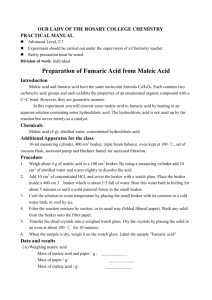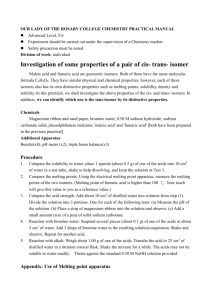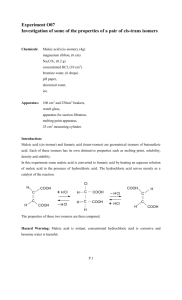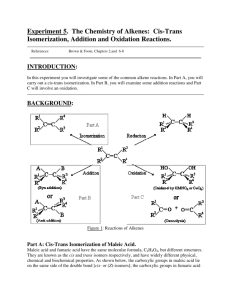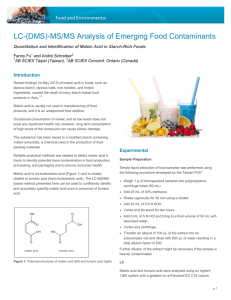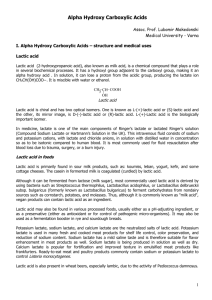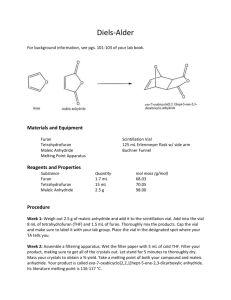Title Cis-trans isomerization of maleic acid to fumaric acid under
advertisement
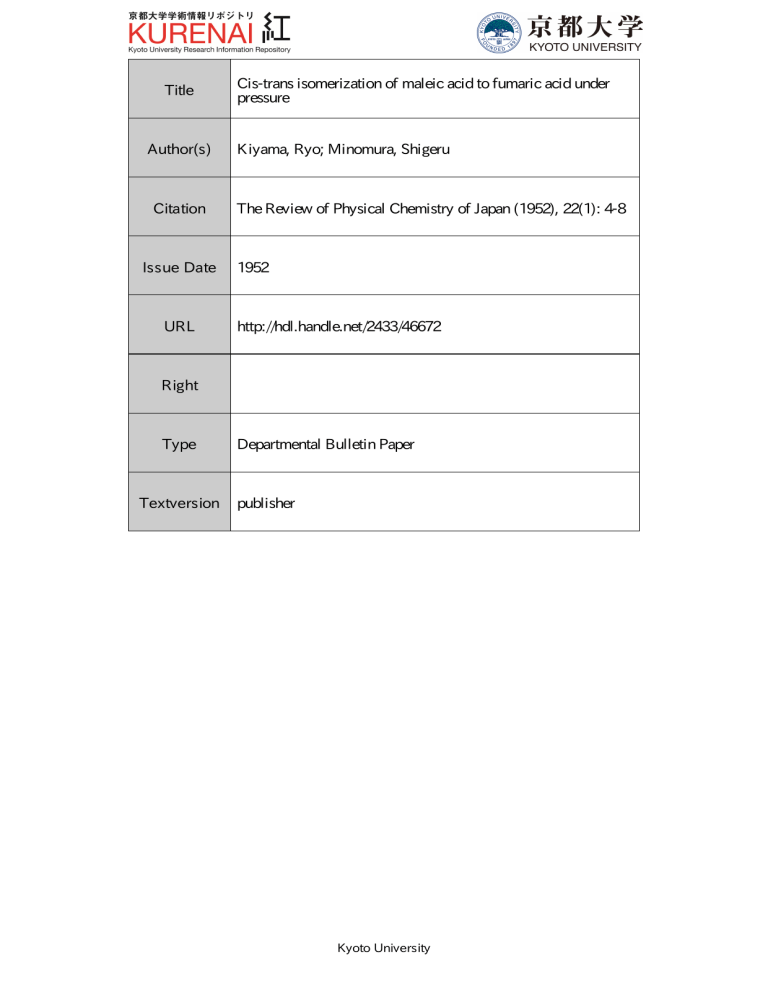
Title
Author(s)
Citation
Issue Date
URL
Cis-trans isomerization of maleic acid to fumaric acid under
pressure
Kiyama, Ryo; Minomura, Shigeru
The Review of Physical Chemistry of Japan (1952), 22(1): 4-8
1952
http://hdl.handle.net/2433/46672
Right
Type
Textversion
Departmental Bulletin Paper
publisher
Kyoto University
The
Review
of Physical
Chemistry
of Japan
I
CIS-TRANS
ISOMERIZATION
TO FUMARIC
OF MALEIC
ACID UNDER
PRESSURE.
By Rvo KrvnuA and Sxrosuu Mrmrntuxa.
Introduction.
ACID
Vol. 22 No.
1 (1952)
The
Review
of Physical
Chemistry
of Japan
Vol. 22 No.
Cis-Trans Isnmerization of Malefic Acid to Fumaric Acid under Yressure
The experimental
apparatus
and procedure
at high pressure
the reports• of This joasrtaal."'•it01 About 0.8 gr of Maleic
vessel was preheated
in a few minutes
A few per cent of Maleic
lation
above described.
acid was
The values
to fumaric
Initial
pressure
was applied.
acid during
the manipu•
1
concentration
in
per
7350
cent
450
900
155
0.3
0.4
O.A
lEi~
7.7
]:3
1.9
1.0
O.fi
17a
1.9
2.1
2.3
2.fi
2.fi
Temp.°C
]800
as follows ~='-`s' Fumaric
to fumaric
acid slightly
250
b2
145' C. They were used as the initial concentration
(8) Determination
of fumaric acid.
The amount of Maleic acid isomerized
tatively
and controlled
are shown in Table 1, being within 0.1 per cent
Table
below
procedure
after the definite
isomerized
are the same as in
acid in the pressure~proof
at about 120`C before the compressing
at the fixed temperature
5
<0.1
of the isomerization.
acid lvas determined
quanti-
soluble is much less soluble in water
than Maleic acid. The solubilities""
in 100 gr water of fumaric and Maleic acids are
0.70 artd 78.8gr at 25°C respectively.
A definite volume of a saturated
aqueous
solution
of fumaric
of a mixture
after
immersing
was filtered
three
acid (0.035 M at G` C)f°' was poured
of Maleic and fumaric
in an ice-water
times with a definite
talein
indicator.
and its filtrate
be detected
bath for about 5 hours.
off with a suction nn a small
The quantity
were
corrected.
aqueous
washed
solution
with about 0.1 N standard
of fumaric
sample
dissolved
The insoluble fumaric
glass filter and carefully
volume of a sattuated
at 0` C. The filtrate was titrated
into an unknown
acids, and Maleic acid was completely
alkali,
of fumaric
acid
using a phenolph•
acid added to the solution
More than 0.8 milligrammes
acid
two or
of the sample
of fumaric
acid could
by this method.
Experimenkal Results.
The transition,
2,250 atm and
therm
has
under the conditions
reaction
an inflexion
of temperatures
time 1/2 hour, is shown
point which
shifts
in Table
125 ^-175° C, pressures
2 and Fig. 1.
to high temperature
with
1
Every isoincrease
in
pressure.
Maleic acid is isomerized
in the liyuld state fastly till the point and in
the solid state slowly after the point. The diagram between the per cent of fumaric
acid isomerized
and the temperature
is plotted in Fig. 2 from Table 2.
(9) R. Kiyama, Tkis jo~nnat, 19, i (1945)
(10) R. Kiyama and T. Yanagimoto, ibid., 21, 3? (7901)
(11) Int. Crit. Table, vol. 4, 25 (1928)
The inflexion
1 (1952)
The Review of Physical
G
R
Kiyama
and
C
1l5
i
gso
I
0:9
~i
9l
10.2
4.g
145
18.0
215
155
zF 2
1800
2250
ii
<0.7
1.1
OS
23.3
10.1
9.1
1.7
30.4
35.3
37.3
1415
53
512
a5.8
21.1
61.7
G7.7
07.1
1f+5
353
39.5
~I5.1
1'75
95.7
49.7
55.8
~o
?z50 atm
175
/~2
time:
hour
i
so
' 7 J~~
ld5
40
I45
~.
t35.i.
o~.'J~~
..~/ 2 ~_
Q
every
shows
lY•00
the
'L250
melting
~yso
-atm
Qtmos.
press.
sa
(-
0
point
ratio
125D atm
Sor
i
0
Qtmos.
l25
isobar
loo
900
•ai
650
735
•150
900
1350
Pressure (atm)
rs. 1
of
~~.
'o
u 145
:rj3~
7Q
OIJSO
3 155
v
iu
'm
point
~ 1800
U 1~5
.,
o.
0.y
1350
2$
ao
.,
o.
soa
0.5
i~
s
cent in 1/2 how
per
135
Rcartron
of the
mixture
under
of various
pressure
temperature
!7S°C
press.
ZO
40
60
Component % (fumaric
Fig. 2
with
100
component
to high
in pressure.
scaled
in the
Table
SO
acid)
shifts
and
increase
The transitions
oG
tube at
3
9~
Transition
GA
40
['/
Atmos.
Press.
Hour
~tiSC
1/2
_~
0
450
45.7
at 175° C
2250
G7.1
20
/IS°C
0
0
'L
Pig.3
4
Time
_
C+
(hour)
9
1 (1952)
2
Transition
TempP
Vol. 22 No
of Japan
S. Minomwa
Table
Atmos.
Press.
Chemistry
1
fi.2
~,~.~
78.5
2
&5.4
s~.n
8,9.2
SO
I
95.0
The
Review
of Physical
Chemistry
of Japan
Cis-Traps Isomerizationof MaleficAcid to Fumaric Acid under Pressure
Vol. 22 No.
7
115--175° C, and under 450 and 2,250 atm at 175°C are shown in Fig. 3 and Table 3.
The isomerization in the sealed tube was not found in 6 hours at 100°C and below
0.1 per cent at 110°C. 1'he curve at 125°C has an inflexion point at the initial stage
of isomerization. Malefic acid is still in the solid state till the point similarly as the
solid state at 115°C and melts partially with fumaric acid after the point Malefic
acid melts completely in the course of isomerization as at 135 and 175°C and svpersaturated fumaric acid is gradually depositted. The curve at 135°C reaches nearly
equilibrium in 10 hours. The transition under pressure at 175°C results in little
increase with pressure.
Discussions.
The main experimental results obtained above can be summarized as follows:
(1) Every isotherm has an inflexion point which shifts to high temperature with
increase in pressure. Malefic acid is isomerized in the liquid state till the point and
in the solid state after the poink (Fig. 1)
(2) The rate of transition increases with pressure till the inflexion point, but
decreases after the point. (Fig. 1)
(3) The amount of transition at the fixed temperature for a few hours results
in little increase with pressure. (Fig. 3)
The melting point of a material shifts to high temperature with increase in
pressure. The values of a number of materials under pressure have been measured
by Bridgnlan1B' and arc found in Ink Crik Table, vol. 9, p. 9, in which are given
the two constants of the parabolic formula t-t°=ap+bp=,
in terms of which Tammann was able to reproduce his results. The rate of transition increases with
pressure, so long as malefic acid melts, but it decreases in the solid state, as the
melting point of malefic acid also shifts to high temperature with increase in pressure.
The effect of pressure of chemical equilibrium is given by the general expression,
`(~l
_~`,
BPJr
where G is Gibbs's free energy, P pressure and V moleculaz volume.
And
R In KadT= dG
where Ka is the equilibrium
constant
under a constant pressure
(1)
(2 )
and given by
([fumaric acid]/(malefic acid])egnit. and dG is the difference of the free energy
between fumaric and malefic acids. From equations (1) and (2),
dlnK,.
1 (1952)
dV '16'""
(12) P. W. 13ridgman,"The Physics aj High Pressure;' London, chap. 7 (1949)
(13) M. G. Evans and M. Polanyi,Trans. Fnrad:Soc.,31,875(1935),32, 7333(193('+),
33,448(1936)
(19) M. G. Evans,-itYiA.,
34. 49 (1938)
i
The
8
Review
of Physical
Chemistry
of Japan
Vol. 22 No.
1 (1952)
It Kiyama and S. Minomura
where
dV is the difference
and dependent
in little
of the moleculaz
on temperature
change
with
volume
and. pressure,
increases
betweenfumaric
When
in temperature
and
and maleic
it is postulated
pressure,
the
that
dV
acid
results
equation,
i
r
is obtained
from the integration.
on the equilibrium:
the densities""
respectively.
I
The molecular
at 20° C under
The difference
of equation
(3) and expresses
volumes of funtaric
atmospheric
and maleic acids calculated
pressure
is -2.009 cc/mole.
the effect of pressure
The isomerization
atmospheric
pressure calculated
from equation (9) to the transition
hours under 2,250 atm, is 99.9 °' in accordance with the experiment.
The authorsareindebted
Cooperative
Research
to the Department
(1'he Fundamental
Research
from
are 70.966 and 72.975 cc/mole
of Education
(95.0 °b) for 9
for the Grant
on High Pressure
Th¢ Laboratory
at 175' C under
of Physical
to the
Industries).
Cltemisfly,
Kyofo Universify.
(]5)
C. D. Hodgman, "Handbook of CGemistry m,d Physics", Cleveland, Ohio, p. F83, 719 (1939)

